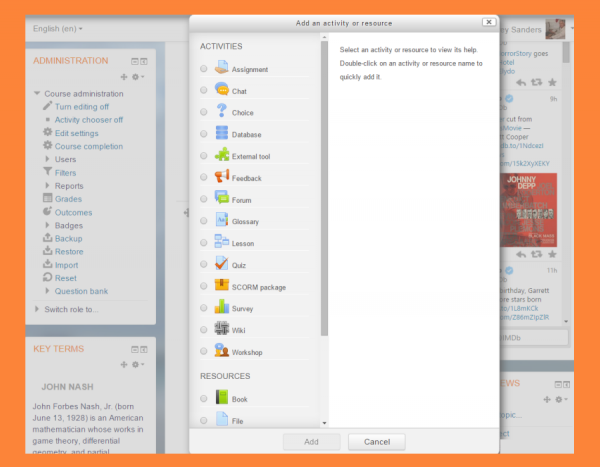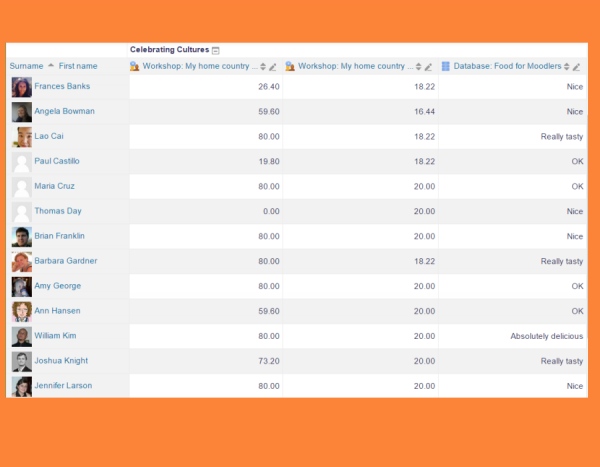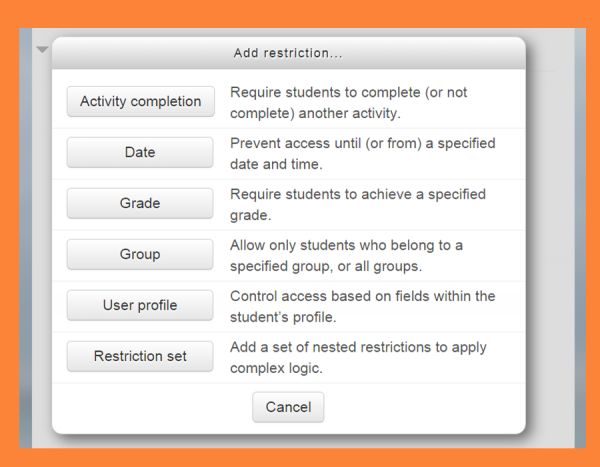Teacher quick guide: Difference between revisions
Helen Foster (talk | contribs) |
Mary Cooch (talk | contribs) (drafting this page) |
||
| Line 1: | Line 1: | ||
In Moodle, a teacher has responsibility for the materials in their own course. They often also manage enrolments and are able to change the layout of the course page. This quick start guide introduces Moodle's features to those with the [[Teacher role]]. | |||
==Teacher guide== | |||
<div class="contentblock"> | |||
<div class="row-fluid"> | |||
<ul class="thumbnails"> | |||
<li class="span6"> | |||
<div class="thumbnail"> | |||
<div class="caption"> | |||
<h4>Course setup</h4> | |||
[[File:tgcoursesetup.png|600px]] | |||
<p>A course is a space on a Moodle site where teachers can add learning materials for their students. A teacher may have more than one course and a course may include more than one teacher and more than one group of learners. See the screencast [https://youtu.be/FKikDYMW_po What is a course?] </p> | |||
<p>By default a regular teacher can't add a new course. See [[Adding a new course]] for information on how courses may be created.</p> | |||
<p>A course can display its materials in a number of ways or 'formats' for example in weekly sections or (named) topic sections. You can show all the sections at once or just reveal one at a time. See [[Course settings]] for more information. or watch the screencast [https://www.youtube.com/watch?v=CNrKtMjQ_8s How to lay out your course].</p> | |||
<p>Course sections may be renamed by turning on the editing and clicking the configuration icon underneath the section name. Sections may also be moved by drag and drop and sections added or removed by clicking the + or - underneath the bottom section. See [[Course homepage]] for more information or watch the screencast on [https://www.youtube.com/watch?v=xOH7Meptnzg Editing course sections] and [https://www.youtube.com/watch?v=46XLOpTcBII Understanding the edit icons].</p> | |||
<p>You can also add elements known as 'blocks' to the right, left or both sides of your central learning area (depending on your theme). For more information see [[Blocks]] and the screencast [https://www.youtube.com/watch?v=MLjT_jyJscs What are blocks?] | |||
</p> | |||
</div> | |||
</div> | |||
</li> | |||
<li class="span6"> | |||
<div class="thumbnail"> | |||
<div class="caption"> | |||
<h4>Adding learning materials</h4> | |||
[[File:tglearningmaterials.png|600px]] | |||
<p>While Moodle can be used for displaying course materials, it is most effective when students can engage with each other and their teacher.Moodle calls static materials such as word processed documents and presentations [[Resources]] and more interactive and graded tasks [[Activities]] The activities available may vary according to what your administrator has enabled in your site and may include non-standard activities installed as extra plugins.</p> | |||
<p>Files and folders can be uploaded via drag and drop as in the screencast [https://www.youtube.com/watch?v=z70iLDWqoGA Dragging and dropping files into Moodle] or via the [[File picker]] as the screencast [https://www.youtube.com/watch?v=KbvhBeeuM4I Uploading files into Moodle] demonstrates. The documentation [[Working with files]] gives more information on how to add different types of files as resources to your course.</p> | |||
<p>When the editing is turned on, Moodle's Activity chooser offers resources and activities for the teacher to select. Clicking on a button displays information about the features of any particular activity so you can see if it meets your needs. For more details, watch the [https://www.youtube.com/watch?t=12&v=yWo0o4tG9YQ Activity chooser] screencast.</p> | |||
<p>Standard activities include [[Forum]], [[Glossary]] and [[Quiz]] Students may submit work to an [[Assignment]] or give their opinions in a customisable [[Feedback]]. The full list of standard activities is here: [[Activities]]. | |||
</p> | |||
</div> | |||
</div> | |||
</li> | |||
</ul> | |||
</div> | |||
<div class="contentblock"> | |||
<div class="row-fluid"> | |||
<ul class="thumbnails"> | |||
<li class="span6"> | |||
<div class="thumbnail"> | |||
<div class="caption"> | |||
<h4>Course enrolment</h4> | |||
[[File:tgcoursenrolment.png|600px]] | |||
<p>Before a learner can access your course, they must first be [[Authentication| authenticated on the site]] and that is the responsibility of the Site administrator.</p> | |||
<p>There are several [[Enrolment methods|enrolment methods]] available to a teacher. What is available again depends on the Moodle administrator. The admin might enrol students into course automatically, or the teacher might be able to enrol students from ''Course administration > Users >Enrolled users''. This is the [[Manual enrolment]] method. Other options can be seen in ''Course administration > Users > Enrolment methods'' and include [[Self enrolment]] and [[Guest access]]. Note that guests can only view the course and its resources; they cannot participate in any activities. An enrolment key may be set if [[Self enrolment]] is enabled so that only students with the key can enter. The screencast [[https://www.youtube.com/watch?v=N74A_ZITL6U How learners access your course]] gives more information on course enrolment.</p> | |||
</div> | |||
</div> | |||
</li> | |||
<li class="span6"> | |||
<div class="thumbnail"> | |||
<div class="caption"> | |||
<h4> Grading </h4> | |||
[[File:tggrading.png|600px]] | |||
<p>Every course in Moodle has its own [[Gradebook]] which records scores from [[Assignment|assignments]] , [[Quiz|quizzes]] , [[Workshop|peer assessment workshops]], [[Lesson|'branching' lessons]] and [[External tool|LTI learning resources]].</p> | |||
<p>Other activies such as [[Forum|forums]], [[Database|databases]] and [[Glossary|glossaries]] can have ratings enabled which will also then be reflected in the gradebook.</p> | |||
<p>Grade items can be manually created from ''Course administration>Grades>Set up>Categories and items'' and it is also possible to [[Grade import|import]] and [[Grade export|export]] grades. | |||
</p> | |||
</div> | |||
</div> | |||
</li> | |||
</ul> | |||
</div> | |||
<div class="contentblock"> | |||
<div class="row-fluid"> | |||
<ul class="thumbnails"> | |||
<li class="span6"> | |||
<div class="thumbnail"> | |||
<div class="caption"> | |||
<h4>Tracking progress</h4> | |||
[[File:tgtracking.png|600px]] | |||
<p>If [[Activity completion|completion tracking]] has been enabled for the site and in ''Course administration > Edit settings'', you can then set completion conditions in activity settings. A checkbox will appear next to the activity and a student may either be allowed to tick it manually, or a tick will display once criteria for that particular activity have been met. This feature can be combined with [[Course completion]] so that when certain activies have been completed and/or grades obtained, the course itself is marked complete. </p> | |||
<p>[[Badges]] can also be issued, manually or based on completion criteria to act as a motivator and record of course progress. | |||
</p> | |||
</div> | |||
</div> | |||
</li> | |||
<li class="span6"> | |||
<div class="thumbnail"> | |||
<div class="caption"> | |||
<h4>Restricting access</h4> | |||
[[File:tgrestrictaccess.png|600px]] | |||
<p>A Moodle course can be set to display everything to everyone all the time, or it can be very restrictive, displaying certain items at certain times, to certain groups or based on performance in previous tasks.</p> | |||
<p>Course items and sections may be manually hidden using the 'hide' icon when the editing is turned on. If [[Conditional activities]] have been enabled by the administrator then a Restrict access section will display in each course activity and resource, allowing you to choose how and when this item will be revealed, and whether to hide it completely or show it greyed out with the conditions for access. | |||
</p> | |||
</div> | |||
</div> | |||
</li> | |||
</ul> | |||
</div> | |||
[[Category:Quick guide]] | [[Category:Quick guide]] | ||
Revision as of 10:20, 15 October 2015
In Moodle, a teacher has responsibility for the materials in their own course. They often also manage enrolments and are able to change the layout of the course page. This quick start guide introduces Moodle's features to those with the Teacher role.
Teacher guide
-
Course setup
A course is a space on a Moodle site where teachers can add learning materials for their students. A teacher may have more than one course and a course may include more than one teacher and more than one group of learners. See the screencast What is a course?
By default a regular teacher can't add a new course. See Adding a new course for information on how courses may be created.
A course can display its materials in a number of ways or 'formats' for example in weekly sections or (named) topic sections. You can show all the sections at once or just reveal one at a time. See Course settings for more information. or watch the screencast How to lay out your course.
Course sections may be renamed by turning on the editing and clicking the configuration icon underneath the section name. Sections may also be moved by drag and drop and sections added or removed by clicking the + or - underneath the bottom section. See Course homepage for more information or watch the screencast on Editing course sections and Understanding the edit icons.
You can also add elements known as 'blocks' to the right, left or both sides of your central learning area (depending on your theme). For more information see Blocks and the screencast What are blocks?
-
Adding learning materials
While Moodle can be used for displaying course materials, it is most effective when students can engage with each other and their teacher.Moodle calls static materials such as word processed documents and presentations Resources and more interactive and graded tasks Activities The activities available may vary according to what your administrator has enabled in your site and may include non-standard activities installed as extra plugins.
Files and folders can be uploaded via drag and drop as in the screencast Dragging and dropping files into Moodle or via the File picker as the screencast Uploading files into Moodle demonstrates. The documentation Working with files gives more information on how to add different types of files as resources to your course.
When the editing is turned on, Moodle's Activity chooser offers resources and activities for the teacher to select. Clicking on a button displays information about the features of any particular activity so you can see if it meets your needs. For more details, watch the Activity chooser screencast.
Standard activities include Forum, Glossary and Quiz Students may submit work to an Assignment or give their opinions in a customisable Feedback. The full list of standard activities is here: Activities.
-
Course enrolment
Before a learner can access your course, they must first be authenticated on the site and that is the responsibility of the Site administrator.
There are several enrolment methods available to a teacher. What is available again depends on the Moodle administrator. The admin might enrol students into course automatically, or the teacher might be able to enrol students from Course administration > Users >Enrolled users. This is the Manual enrolment method. Other options can be seen in Course administration > Users > Enrolment methods and include Self enrolment and Guest access. Note that guests can only view the course and its resources; they cannot participate in any activities. An enrolment key may be set if Self enrolment is enabled so that only students with the key can enter. The screencast [How learners access your course] gives more information on course enrolment.
-
Grading
Every course in Moodle has its own Gradebook which records scores from assignments , quizzes , peer assessment workshops, 'branching' lessons and LTI learning resources.
Other activies such as forums, databases and glossaries can have ratings enabled which will also then be reflected in the gradebook.
Grade items can be manually created from Course administration>Grades>Set up>Categories and items and it is also possible to import and export grades.
-
Tracking progress
If completion tracking has been enabled for the site and in Course administration > Edit settings, you can then set completion conditions in activity settings. A checkbox will appear next to the activity and a student may either be allowed to tick it manually, or a tick will display once criteria for that particular activity have been met. This feature can be combined with Course completion so that when certain activies have been completed and/or grades obtained, the course itself is marked complete.
Badges can also be issued, manually or based on completion criteria to act as a motivator and record of course progress.
-
Restricting access
A Moodle course can be set to display everything to everyone all the time, or it can be very restrictive, displaying certain items at certain times, to certain groups or based on performance in previous tasks.
Course items and sections may be manually hidden using the 'hide' icon when the editing is turned on. If Conditional activities have been enabled by the administrator then a Restrict access section will display in each course activity and resource, allowing you to choose how and when this item will be revealed, and whether to hide it completely or show it greyed out with the conditions for access.




